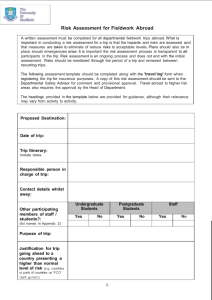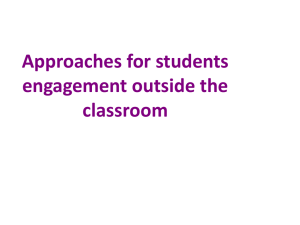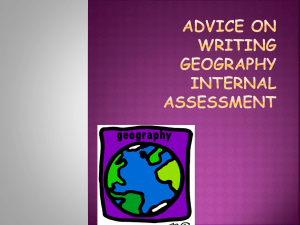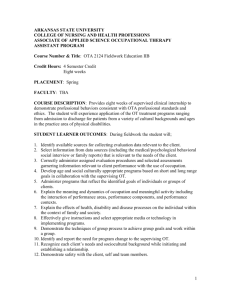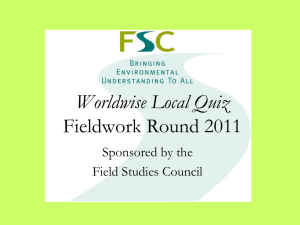Field Risk Assessment - Department of Earth Sciences
advertisement
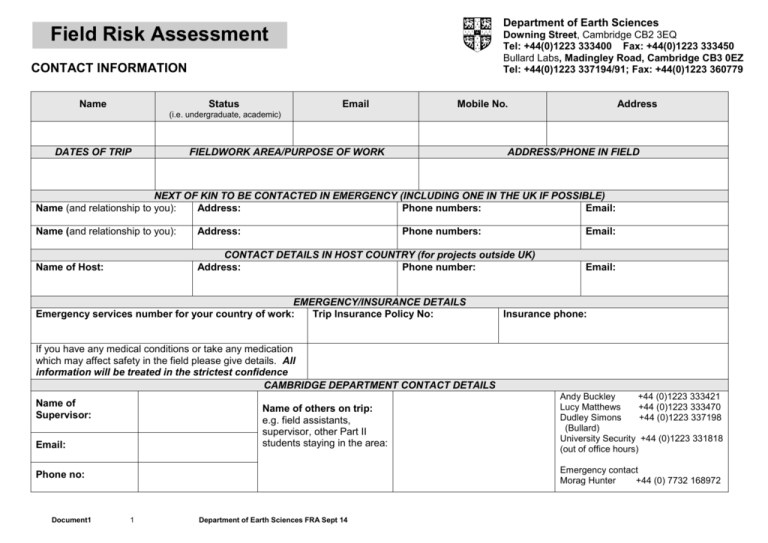
Department of Earth Sciences Field Risk Assessment Downing Street, Cambridge CB2 3EQ Tel: +44(0)1223 333400 Fax: +44(0)1223 333450 Bullard Labs, Madingley Road, Cambridge CB3 0EZ Tel: +44(0)1223 337194/91; Fax: +44(0)1223 360779 CONTACT INFORMATION Name Status Email Mobile No. Address (i.e. undergraduate, academic) DATES OF TRIP FIELDWORK AREA/PURPOSE OF WORK ADDRESS/PHONE IN FIELD NEXT OF KIN TO BE CONTACTED IN EMERGENCY (INCLUDING ONE IN THE UK IF POSSIBLE) Name (and relationship to you): Address: Phone numbers: Email: Name (and relationship to you): Address: Phone numbers: Name of Host: CONTACT DETAILS IN HOST COUNTRY (for projects outside UK) Address: Phone number: EMERGENCY/INSURANCE DETAILS Emergency services number for your country of work: Trip Insurance Policy No: Email: Email: Insurance phone: If you have any medical conditions or take any medication which may affect safety in the field please give details. All information will be treated in the strictest confidence CAMBRIDGE DEPARTMENT CONTACT DETAILS Name of Supervisor: Name of others on trip: e.g. field assistants, supervisor, other Part II students staying in the area: Email: Emergency contact Morag Hunter +44 (0) 7732 168972 Phone no: Document1 Andy Buckley +44 (0)1223 333421 Lucy Matthews +44 (0)1223 333470 Dudley Simons +44 (0)1223 337198 (Bullard) University Security +44 (0)1223 331818 (out of office hours) 1 Department of Earth Sciences FRA Sept 14 Hazardous Situation/Activity Potential Risk Control Measures Please use the information on the following pages as a guide to select, delete, or add hazards and control measures, as appropriate, for your particular fieldwork. Travelling to and from the field area. Transport around the area during the trip. Embarkation/disembarkation from vehicles, especially at roadside. Cars approach from opposite direction to UK. Injuries to pedestrians. Scheduled flights, trains, coaches Use professional drivers or maintain safe driving (driver training where appropriate) Use high viz vests and markers for road cut exposures Exercise on long haul flights to avoid deep vein thrombosis Heat stroke, dehydration/hypothermia sunburn Discomfort/hypothermia Reduction in visibility, lightning strikes Suitable clothing and sufficient water/carry thermal blanket Wear hat and sunscreen Carry waterproofs, extra warm layers, survival bag Know compass direction and terrain to ensure follow route out Leave mountain ridges immediately Wildlife and vegetation: Insects, animals Plants may cause skin irritation Bites, stings, attack by animals Lyme disease Rash on exposed skin Local factors - diseases and hygiene e.g. Weil’s disease Sickness Dress code and behaviour Could offend local customs leading to abuse Maintain vigilance, wear long trousers and long sleeved shirts. Check for ticks and remove immediately. Rabies inoculations before travel increases time available for follow-up treatment. Immunisation, suitable medicines Ensure personal hygiene and always wash hands before eating. Use of anti-bacterial wash if limited clean water available Familiarise yourself with customs so you can behave and dress appropriately. Accommodation: Hotel, field centre or camping Fire Carbon monoxide poisoning Security Remote areas - getting help; coping with a problem... Delay in rescue or treating illness or injury Weather/climate: Extremes of temperature; high/low sunshine Rain/getting wet Sudden changes in weather or storms Document1 2 Personal injury; damage to vehicles in traffic accident Department of Earth Sciences FRA Sept 14 Familiarise yourself with the fire drill and escape route Do not use or refuel stove inside tent. Ensure good ventilation of cabin when using gas heaters and cooking facilities. Never leave gas heaters on overnight. Never cook in tent. Do not bring still smouldering embers into tent. Keep valuables out of sight. Buddy system or contact arrangements. Use route cards. Mobile phone. 4 dept walkie-talkies available. Consider taking a First Aid training course or 2-day Fieldwork Safety and First Aid Course. Hazardous Situation/Activity Potential Risk Control Measures Please use the information on the following pages as a guide to select, delete, or add hazards and control measures, as appropriate, for your particular fieldwork. Personal safety and First Aid provision: Accidents Exacerbation of medical condition Obtain basic first aid competence and carry first aid kits Maintenance of buddy system. Tell others of medical conditions and symptoms. Ensure tetanus injection is in date. Lone Working: Difficulty of calling for assistance in event of an accident Carry a whistle Buddy system – details of mobile phone contact at regular time intervals if outside sight and sound of rest of field party. Falling rocks, landslide. Slips, trips and falls Falling in water, getting wet and then cold, injury Slow walkers getting left behind Terrain: Rock faces, cliffs, screes, landslide steep/slippery/unstable slopes, caves. Rivers, streams and marshy areas, deep bogs, flash floods. Coastal conditions: Rough sea, tides coming in, abnormal waves, rip tides, quicksands, cliff instability Falling in sea, exit route cut off by tide. drowning Hammering rock samples Eye damage by flying rock chips Hard hats Do not climb unless you are sure it is safe. Take extra care when crossing streams. Be particularly careful when going to the assistance of someone who has fallen in. Maintain vigilance (do not camp) in wadis or areas liable to flooding Throw lines may be a useful addition to safety equipment. Ensure knowledge of correct use Do not swim unless you have separate risk assessment covering the adequate life saving facilities present. Goggles, warn people nearby before hammering. Carrying heavy rucksacks of samples Back strain Make more than one journey if necessary Environmental impact: Litter, Fires, Sharp chippings Environmental damage Fires "Carry it in, carry it out." Do not make fire unless you are sure it will be safe, and is allowed. Sharp chippings can damage animals’ feet Leave any rock shards tidied up inconspicuously. Further hazards Above suggestions do not cover all hazards. Consider further hazards applicable to your area. Document1 3 Department of Earth Sciences FRA Sept 14 Hazardous Situation/Activity Potential Risk Control Measures Please use the information on the following pages as a guide to select, delete, or add hazards and control measures, as appropriate, for your particular fieldwork. Further hazards (continued) General Notes General travel arrangements: passport, visa, money, insurance…... Communication, especially in emergency: Use mobile phones in areas where reception is available. Have emergency numbers to hand. Have a whistle readily to hand. The international distress call is six short blasts repeated at one minute intervals. Daily monitoring and feedback; daily briefing and debriefing; rendezvous; cut-off times; route cards Moderation with alcohol, etc.; getting enough sleep, fitness preparation, proper diet in run-up period Adequate food and drink each day, including breakfast. Emergency water and food N.B. Consider the Geologists’ Association Fieldwork Code (http://www.geolsoc.org.uk/~/link.aspx?_id=0F5D9BDE-4E91-490C-8A66B8E96B52377E&_z=z). Signature Supervisor’s signature (if applicable) Name (Please print) Name (Please print) Position: (e.g. Academic, part II/ research student/post-doc) Date: Lucy Matthews (lhm29@cam.ac.uk) and Celia Hobbs (cjh91@hermes.cam.ac.uk) are happy to advise you on writing your risk assessment and can lend First Aid kits and other safety equipment for your trip: http://www.esc.cam.ac.uk/resources/healthand-safety/fieldwork-safety Please make 2 copies of this form to be given to: Lucy Matthews or Celia Hobbs and your supervisor Document1 4 Department of Earth Sciences FRA Sept 14

